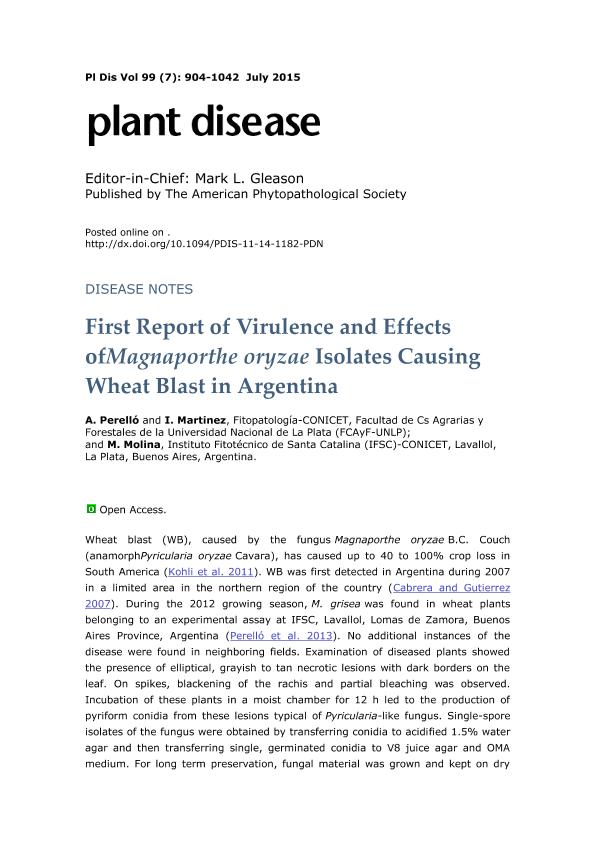Artículo
First report of virulence and effects of Magnaporthe oryzae isolates causing wheat blast in Argentina
Fecha de publicación:
06/2015
Editorial:
American Phytopathological Society
Revista:
Plant Disease
ISSN:
0191-2917
Idioma:
Inglés
Tipo de recurso:
Artículo publicado
Clasificación temática:
Resumen
Wheat blast (WB), caused by the fungus Magnaporthe oryzae B.C. Couch (anamorph Pyricularia oryzae Cavara), has caused up to 40 to 100% crop loss in South America (Kohli et al. 2011). WB was first detected in Argentina during 2007 in a limited area in the northern region of the country (Cabrera and Gutierrez 2007). During the 2012 growing season, M. grisea was found in wheat plants belonging to an experimental assay at IFSC, Lavallol, Lomas de Zamora, Buenos Aires Province, Argentina (Perelló et al. 2013). No additional instances of the disease were found in neighboring fields. Examination of diseased plants showed the presence of elliptical, grayish to tan necrotic lesions with dark borders on the leaf. On spikes, blackening of the rachis and partial bleaching was observed. Incubation of these plants in a moist chamber for 12 h led to the production of pyriform conidia from these lesions typical of Pyricularia-like fungus. Single-spore isolates of the fungus were obtained by transferring conidia to acidified 1.5% water agar and then transferring single, germinated conidia to V8 juice agar and OMA medium. For long term preservation, fungal material was grown and kept on dry filter paper in polypropylene tubes. M. oryzae was also successfully isolated during 2013 from native weeds and grasses (Stenotaphrum secundatum, Setaria sp., Eleusine sp., Bromus unioloides, Lolium perenne, Echinochloa crus-galli, Avena fatua, and Cynodon dactylon) growing adjacent to wheat and rice fields belonging to the Experimental Station Julio Hirschhorn, Los Hornos-FCAyF, UNLP. Pathogenicity tests were conducted using 10 isolates from wheat and five isolates from grasses. Fungal suspensions (1 × 105 conidia per ml) were spray-inoculated on wheat seedling (Zadoks’ growth stage 14) and at heading (Zadoks’ growth stage 61) on cultivars BioINTA 3004 and Baguette 18 (Zadoks et al. 1974). Plants were incubated in a moist chamber at 22°C and 100% RH for 48 h. Disease severity was estimated in each strain-wheat cultivar combination at 10, 13, and 17 days after inoculation. Symptoms were similar to those observed in the field, while the control treatment remained symptomless. Leaf infection ranged from 2.7 to 64.3% and different phenotypic reactions were observed such as pinhead-sized spots; small or enlarged brown lesions with no distinguishable center; and the typical blast lesions, elliptical or roughly diamond-shaped with gray centers and a thin, brown border. On spikes, partial or total bleaching of spikes was observed up to 50% severity. Necrosis of the glumes and rachis was occasionally observed. Thousand seed weight was significantly reduced by fungal infection (63.1%). Reduction of grain germination (43.6%), seed rot, and seedling rot and blight were also observed after in vitro inoculations of grain. The pathogen was reisolated from lesions using the methods previous described, confirming Koch’s postulates. Morphobiometrical characteristics of the typical pyriform (pear-shaped) hyaline 2-septate conidia of the recovered isolates were in agreement with the identification of the fungus as M. oryzae (Subramanian 1968). A culture specimen was deposited in the IFSC herbarium (No. PGW0812). Our results indicate that M. oryzae has established itself in the principle wheat agroecological region of Buenos Aires, Argentina, and may pose a significant threat to wheat production, and therefore poses a significant threat to wheat production in Argentina.
Palabras clave:
Pyricularia Grisea
,
Wheat
,
Pathogenicity
Archivos asociados
Licencia
Identificadores
Colecciones
Articulos(CCT - LA PLATA)
Articulos de CTRO.CIENTIFICO TECNOL.CONICET - LA PLATA
Articulos de CTRO.CIENTIFICO TECNOL.CONICET - LA PLATA
Citación
Perello, Analia Edith; Martinez, I.; Molina, María del Carmen; First report of virulence and effects of Magnaporthe oryzae isolates causing wheat blast in Argentina; American Phytopathological Society; Plant Disease; 99; 8; 6-2015; 1177-1177
Compartir
Altmétricas




